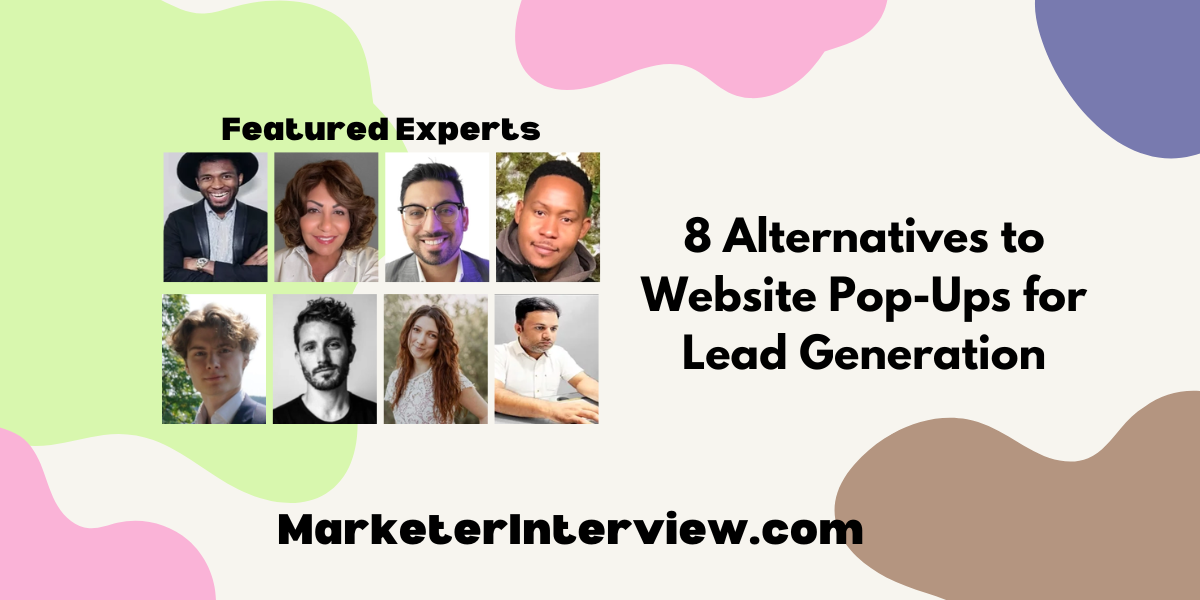8 Alternatives to Website Pop-Ups for Lead Generation
Seeking alternatives to the often intrusive website pop-ups, we’ve gathered insights from eight seasoned professionals, including founders and CEOs. They share specific strategies ranging from implementing slide-ins for subtlety to leveraging social media contests, providing a spectrum of ideas for effective lead generation without the pop-up.
Want to get quoted in MarketerInterview.com content just like this? Apply to become a contributor today!
Contents
Implement Slide-Ins for Subtlety
We’ve pretty much replaced all pop-ups with slide-ins (on the sites we manage that use them). They are less intrusive, look cleaner, and have had very similar results—if not better.
People tend to tune out pop-ups these days. Slide-ins, on the other hand, are a bit more subtle and less disruptive. I consider them to be a more modern, user-friendly alternative to traditional pop-ups.

David Martirosian, Founder, Galaxy Growth Media
Chatbots Enhance User Engagement
I often face the challenge of balancing user experience with effective lead-generation strategies. One specific alternative to traditional website pop-ups that I find particularly effective is the use of a well-integrated chatbot.
Chatbots can have various functions on a website, such as providing customer support and engaging visitors by offering relevant assistance or information based on the content they are viewing. This approach is less intrusive than pop-ups, which can disrupt the user experience and sometimes lead to frustration or site abandonment.
When integrating a chatbot, it’s important to carefully plan natural language processing and user interaction. The aim is to create a responsive and helpful chatbot without being too pushy. For instance, the chatbot can greet a visitor after they’ve spent a certain amount of time on a page, and offer personalized assistance based on the section of the site they are exploring. This could involve asking if they need help with a specific product or service, or offering a downloadable resource related to the content they are viewing.
The key to a successful lead-generation chatbot lies in its ability to recognize user intent by analyzing the pages a visitor accesses. This allows the chatbot to determine the potential products or services they are interested in and guide them towards providing their contact information voluntarily. For example, if a visitor spends time on a page about web development services, the chatbot can offer a free consultation or an exclusive white paper on web development trends, prompting them to leave their email address to receive the resource.
Furthermore, implementing a chatbot also offers valuable insights through data collection. By monitoring the questions and interactions that visitors have with the chatbot, companies can gain a better understanding of common concerns or interests. This understanding allows for continuous improvement of both the website content and the chatbot’s algorithms.
In my opinion, chatbots are a powerful tool for improving user engagement and generating leads. They enable more natural interactions with visitors, leading to higher quality leads based on users’ specific needs and timing. Unlike disruptive pop-ups, this method respects the user’s experience and timing.

Derrick Boddie, Senior Web Developer & Executive Director, Mango Innovation
Interactive Demos Increase Leads
A good way to capture more leads is to create interactive demos on your website. This gives you better leads and a feature to market on social media. Making a website more interactive—a focus on conversion—is a good and easy way to make potential customers more likely to contact you. I have tried it on many different websites. Lead generation went up by 13%-27%, depending on the industry.

Moritz Junker, CEO, Netsius
Offer Content Upgrades
One alternative to website pop-ups for lead generation is using content upgrades. This involves offering additional resources, such as free e-books, checklists, or templates, in exchange for contact information.
For example, providing a downloadable guide related to a blog post can encourage readers to subscribe. This method captures leads while giving your audience valuable and relevant content they find useful, improving their overall experience on your site.

Matias Rodsevich, Founder & CEO, PRLab
Provide Actionable Free Resources
Free resources are one of my favorite approaches to lead generation. They offer a compelling alternative to traditional pop-ups, which can feel almost forced and ultimately interfere with your users’ experience. By creating a dedicated page with actionable content tailored to address your audience’s challenges, you can establish yourself as a trusted authority in your field.
I recommend showcasing these free resources prominently so that visitors can easily find them, no matter where they land on your website. Integrate them across your homepage, blogs, and service pages. Each resource should promise to solve a common problem your visitors face, creating a win-win scenario. With a simple form, visitors can access the information, and you gain a high-quality lead already invested in your expertise.
This strategy not only delivers immediate value but also fosters trust and credibility. Your leads receive practical solutions, and you benefit from a growing list of engaged prospects who view you as a reliable partner on their journey to success.

Elisabeth Hedge, Website Designer, Elisabeth Hedge
Engage with Interactive Quizzes
A substitute for website pop-ups, which I find useful, is making interactive quizzes or assessments. These get visitors involved more excitingly, providing up-front value while subtly gathering important information.
For example, as a digital marketer, I have observed businesses employing niche-targeted quizzes. These quizzes aim to answer the most common problems or interests of their target market. The results can be personalized, and responses obtained via quizzes may prompt consumers to share contact information like email addresses.
This style feels less invasive than the traditional pop-up because it provides immediate value and creates customized experiences. It also helps qualify leads by their reactions to questions so that more targeted follow-ups and conversions may occur.
From the user’s standpoint, interactive quizzes are engaging and informative, so they readily participate in them. Thus, businesses can collect leads and build trust and credibility.

Fahad Khan, Digital Marketing Manager, Ubuy Nigeria
Integrate Embedded Forms
Embedded forms within content are an effective alternative to website pop-ups for lead generation purposes.
Let’s be honest, pop-ups almost always disturb the user experience, causing frustration and higher exit rates.
In fact, they are particularly intrusive on mobile devices, where screen display space is limited.
In contrast, embedded lead-generating forms will actually provide a smooth and subtle experience to the users, allowing them to interact naturally without being disturbed.
By choosing this approach, we will significantly improve the website’s content flow, which, in turn, will increase the likelihood of visitors swiftly completing their information.
The integration of such forms will not only successfully acquire crucial leads but also show off our commitment to providing an intuitive, user-friendly marketing plan.

Gabriel Kaam, CEO, KNR Agency
Leverage Social Media Contests
As the owner of Elite Travel, I’ve witnessed the evolution of lead-generation strategies over the past three decades. Initially, we gave away simple trips at bridal shows and events—a straightforward yet practical approach at the time. However, as digital platforms transformed marketing, we shifted our focus to social media, significantly expanding our reach and modernizing our lead-generation methods.
One effective alternative to website pop-ups for lead generation that we have leveraged is social media contests. These contests generate excitement and engagement and allow us to collect clean, targeted leads. By offering trip giveaways on platforms like Facebook, Instagram, and Twitter, participants fill out forms that ask specific questions about their travel plans, such as their intended destination and travel dates. This information helps us tailor our offerings and communications more effectively to their needs.
The key advantages of using social media contests over traditional pop-ups are engagement quality and the depth of data collected. Participants are more willing to provide detailed information in exchange for a chance to win a valuable prize like a trip they are already interested in. Additionally, social media platforms offer the ability to reach a broader audience organically or through targeted ads, enhancing the visibility of the contest and, by extension, our brand.
I advise businesses to adopt this method to ensure clear communication about the opt-in process for future promotions. It’s crucial to make the opt-in option explicit to maintain compliance with data protection regulations and to build trust with your audience. This approach respects user privacy and ensures that the leads generated are genuinely interested in your offerings, enhancing the effectiveness of follow-up marketing campaigns.
In conclusion, social media contests are a dynamic and user-friendly alternative to website pop-ups for lead generation. They provide a platform for interactive engagement, precise targeting, and high-quality lead collection, making them an invaluable tool for any business looking to expand its customer base and enhance its marketing efforts.

Tammy Levent, President, Elite Travel Management Group, Inc.
Want to get quoted in MarketerInterview.com content just like this? Apply to become a contributor today!






